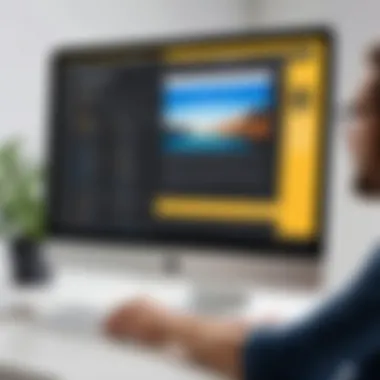Mastering JavaScript for Effective Product Tours


App Overview
Preamble to the app and its main features
The app in focus can serve many purposes, but let’s imagine it as a task management tool. Users can create, edit, and organize tasks efficiently. It features intuitive navigation, customizable task categories, and notifications for deadlines. These functionalities aim to streamline users’ productivity and enhance their overall experience.
Key functionalities and benefits of the app
- Intuitive User Interface: The design is simple, reducing the learning curve for new users.
- Customization Options: Users can personalize settings to suit their workflows.
- Collaborative Features: Functionality for sharing tasks with teams enhances cooperative projects.
- Mobile Compatibility: Users can access and manage tasks on-the-go.
The advantages of using this app extend beyond task management. It promotes organization, improves time management skills, and facilitates collaboration. These benefits are crucial, especially in a fast-paced work environment where managing tasks efficiently can lead to higher productivity.
Step-by-Step Walkthrough
Creating an effective product tour involves careful planning and execution. Here is a breakdown of how to set up an engaging experience for new users.
- Preparation: Define key features to highlight, such as task creation and deadlines.
- JavaScript Coding: Use libraries like Intro.js or Shepherd.js to build interactive tutorials that guide users through the app.
- Visual Aids: Capture screenshots of each key area and apply these images to your product tour.
- User Testing: Gather feedback on the product tour to refine it. Adjust the walkthrough based on user experience to ensure clarity.
The product tour methodology is as vital as the app itself, as it directly influences user retention.
Tips and Tricks
To enhance the effectiveness of the product tour:
- Keep It Short: Users appreciate concise tours that get straight to the point.
- Interactive Elements: Include buttons users can click to help them learn by doing.
- Highlight Hidden Features: Often, there are functionalities that users may not discover without guidance. Bring attention to these to enrich the user's experience.
Common Issues and Troubleshooting
During implementation, some challenges may arise:
- Browser Compatibility: Make sure that the tour functions properly across different web browsers. Testing can help identify discrepancies.
- User Confusion: If users seem confused, gather data on which steps are most skipped, and reevaluate those parts.
- Performance Issues: Ensure that the tour does not slow down the app's loading times, as this can diminish user satisfaction.
App Comparison
When comparing our task management app with competitors, it becomes clear what it does uniquely well:
- User-Centric Design: Many competitors may have cluttered interfaces, while this app focuses on simplicity.
- Customizable Features: Competitors often offer limited customization; this app provides extensive options.
- Robust Collaborations Tools: Unlike others, this app excels in features that enhance teamwork.
Understanding Product Tours
Understanding product tours is essential to enhance user onboarding, leading to a better user experience and increased retention. A product tour serves as a roadmap, guiding users through the features of an application while minimizing confusion. By leveraging a well-structured product tour, developers can ensure that users grasp how to utilize the app effectively from the onset.
The significance of product tours extends beyond mere tutorials. They act as a bridge connecting users with the product’s core functionalities. This is especially important in complex applications where users can feel overwhelmed. A product tour can highlight key features, thereby improving usability and satisfaction.
Purpose of Product Tours
Product tours have several key purposes that contribute to their utility:
- Guided navigation: They provide a step-by-step walkthrough of essential features, facilitating an easier transition into the application.
- Increased engagement: By showcasing various functionalities, product tours keep users interested and encourage exploration.
- Reduction of frustration: Users who understand how to navigate the app are less likely to encounter confusion, which can lead to frustration and abandonment.
In essence, product tours can significantly enhance the overall experience for new users. They help in making a complex product appear more accessible and user-friendly.
User Onboarding Process
The user onboarding process is a critical phase in a user’s journey that directly relates to product tours. Effective onboarding can ensure that users engage with the product correctly and efficiently from the start. This process includes several stages:
- Awareness: Users become aware of the product's features through initial prompts and guides.
- Engagement: During this phase, users are invited to interact with the product, often supported by product tours that lead them through the interface.
- Retention: A well-constructed tour can enhance usability, promoting the likelihood that users will return.
A successful onboarding experience through product tours is integral to increasing user satisfaction and retention. A product that is easy to understand is more likely to keep users engaged over time. In summary, understanding product tours sets the stage for implementing a cohesive user onboarding process that promotes active engagement and long-term user satisfaction.
Basic Concepts of JavaScript for Product Tours
Understanding the basic concepts of JavaScript is essential for creating effective product tours. This knowledge serves as the foundation upon which developers can build engaging and interactive experiences for users. By grasping JavaScript fundamentals and its relationship with the Document Object Model (DOM), developers can enhance user onboarding and product usability. This section delves into two main pillars: JavaScript fundamentals and DOM manipulation.
JavaScript Fundamentals
JavaScript is a powerful programming language that enables dynamic interactions on web pages. For product tours, its fundamentals are particularly important. Developers should be familiar with key concepts such as variables, data types, functions, and control structures. These elements form the core of JavaScript coding and inform decisions during tour creation.
- Variables: Variables store data and can hold various types, such as strings, numbers, and objects. Understanding how to declare and use variables is fundamental.
- Functions: Functions encapsulate reusable blocks of code. They enhance modularity, allowing developers to define the actions that guide users through product features.
- Control Structures: Conditional statements and loops help manage the flow of a program. These structures can control what content is displayed to users based on their interactions.


By mastering these fundamentals, developers can create scripts that respond effectively to user actions and generate dynamic content that captures attention.
DOM Manipulation
DOM manipulation is crucial for implementing product tours. The DOM represents the structure of a web page as a tree of objects, allowing JavaScript to interact with HTML elements. This interaction creates the seamless experience users expect during onboarding.
To effectively manipulate the DOM, developers should understand the following concepts:
- Selecting Elements: JavaScript provides various methods, such as , , and others, to select HTML elements. These methods enable targeting specific parts of a product tour, like buttons or tooltips.
- Modifying Elements: Developers can change the content, style, or attributes of selected elements. For example, showing or hiding elements based on user actions can clarify navigation.
- Event Handling: JavaScript allows developers to listen for user events, such as clicks or key presses. By handling these events, developers can trigger actions that guide users through the tour.
Here's a simple example of how DOM manipulation might look in code:
In this example, clicking the 'next-button' will change the text of the 'feature-description' element, demonstrating a simple yet effective way to guide users through a product tour.
By grasping these basic concepts of JavaScript, developers can effectively create product tours that not only inform but also engage users, leading to a more satisfying onboarding experience.
Frameworks and Libraries for Building Product Tours
Building effective product tours often requires a structured approach. Using frameworks and libraries is important because they provide pre-built components that save time and effort. This leads to a more efficient development process. Developers can focus on customizing the tours rather than starting from scratch. These tools encourage consistency in design and behavior across the tour elements. Libraries often include useful features such as animations and transitions, which enhance the overall user experience.
Overview of Available Libraries
A variety of libraries exist that can help in creating product tours. Some popular options are Intro.js, Shepherd.js, and Hopscotch. Each library has unique features:
- Intro.js is favored for its simplicity and ease of use. It allows for quick setup and customization.
- Shepherd.js offers more advanced features, including step customizations and better control over positioning elements.
- Hopscotch is known for its flexibility, letting developers create complex tours with various user interactions.
When selecting a library, consider factors such as compatibility, support, and the complexity of the tours you want to create. Ensure the chosen library integrates well with your existing tech stack.
Choosing the Right Framework
Selecting the right framework for building product tours is a strategic decision. It involves understanding the specific needs of your project. Consider these key aspects:
- Ease of Integration: The library should blend smoothly with your current codebase.
- Feature Set: Ensure it offers the features essential for your product tours, like tooltips and highlights.
- Community Support: A well-supported library means better resources and updates over time.
- Performance: Choose a library that does not slow down your application.
Analyzing these factors can help you make an informed choice. Platforms like reddit.com often have discussions on best practices, making them a valuable resource.
"Choosing the right library can significantly affect user engagement with your product tours."
By carefully considering these points, you can enhance both the user experience and the overall efficiency of your development process.
Designing Effective Product Tours
Designing effective product tours is crucial for maximizing user engagement and ensuring a positive onboarding experience. A well-crafted tour not only introduces users to a product but also highlights its key features and functionalities. This process can significantly enhance user retention and satisfaction. When carefully designed, product tours can provide clarity, reduce confusion, and foster user confidence in navigating an interface.
In this section, we explore essential elements that contribute to effective product tours. Attention to user-centric principles, visual hierarchy, and clarity are all integral to creating an engaging experience. The demands of modern users require that tours are not only informative but also intuitive.
User-Centric Design Principles
User-centric design principles focus on understanding and prioritizing the needs and behaviors of users. This approach can determine the success of a product tour. Employing a user-centered method involves several key considerations:
- Empathy Mapping: Knowing users' pain points and expectations is fundamental. Empathy maps help to capture these insights.
- Personalization: Tailoring tours based on user profiles can greatly enhance relevance. For instance, new users may benefit from more comprehensive walkthroughs than returning users.
- Feedback Loops: Implementing mechanisms to gather user feedback during the tour can guide improvements. Prompting users to share their thoughts ensures that the experience evolves.
By applying these principles, product tours become more aligned with user needs. The result is an experience that feels personal and thoughtful, increasing overall engagement.
Visual Hierarchy and Clarity
Visual hierarchy directs attention to important elements of the product tour and reduces cognitive load on users. When users first encounter a product, their attention should naturally gravitate towards critical features. Key strategies for establishing a strong visual hierarchy include:
- Contrast and Color: Utilize contrasting colors to differentiate elements. Bright buttons or highlighted areas can draw users’ attention where it matters most.
- Size and Scale: Larger elements are often perceived as more important. Make primary calls to action larger compared to secondary messages.
- Spacing and Alignment: Proper alignment and use of whitespace can guide the user's eye through the tour. Well-structured layouts lead to enhanced clarity.
The objective is to create a seamless experience where information is presented clearly. Users should not feel overwhelmed but rather guided intuitively through their journey.
Designing product tours with these principles can greatly reduce user frustration and confusion.
Integrating JavaScript with HTML and CSS
Integrating JavaScript with HTML and CSS is a crucial step in creating effective product tours. This integration not only enhances the user experience but also ensures that the tours are engaging and functional. By combining these three technologies, developers can create seamless interactions within their applications. JavaScript can manipulate HTML elements and dynamically change CSS styles, creating a rich user interface. This capability allows for the development of tours that can effectively guide users through features in real time, adapting to their needs as they navigate through an app.
The benefits of this integration are significant. First, it allows for responsive changes in the user interface based on user interactions. For instance, if a user completes a task, the product tour can instantly adjust to showcase the next relevant feature. Second, using JavaScript to control CSS styles enables developers to create visually appealing tours, ensuring that users remain engaged. This capability supports creating animations that help maintain attention and improve understanding.


However, there are considerations that developers must keep in mind. Performance is one of the key factors. Too much JavaScript can lead to slower load times and affect overall user experience. Thus, it is essential to strike a balance between functionality and efficiency. Developers should also consider ensuring cross-browser compatibility when integrating these technologies.
Basic Integration Techniques
When integrating JavaScript with HTML and CSS, developers often start with basic techniques. A common approach is manipulating the DOM (Document Object Model). This involves selecting HTML elements using methods like or and then applying changes through JavaScript.
For example, to start a tour when a user clicks a button:
This simple example demonstrates how a single click can trigger a complex series of interactions. Moreover, JavaScript can modify CSS properties directly through the style attribute. Consider the following code snippet:
Here, setting the display property to 'block' makes a specific tour element visible.
Enhancing Tours with CSS Styles
CSS plays a significant role in optimizing the visual aspects of product tours. By leveraging CSS styles, developers can create attractive and clear presentations that guide users without confusion. This is where effective design principles come into play.
For instance, using transitions and animations can greatly enhance the perceived fluidity of a product tour. A simple fading effect can make transitions between steps feel more natural:
In this code, the opacity changes gradually for a smoother user experience. This small touch can make a significant difference.
Furthermore, employing CSS grid or flexbox can ensure that the layout of the product tour elements is responsive. This ensures that all users, regardless of device size, have a consistent experience. It is paramount to test these styles across different screens to maintain usability.
Integrating JavaScript with HTML and CSS effectively is a foundational skill for developers looking to create impactful product tours. Making user experiences smooth and visually appealing can lead to enhanced engagement and satisfaction.
Implementing Product Tour Workflow
Implementing a product tour workflow is a cornerstone of effective user onboarding. This stage ensures that new users gain immediate familiarity with an application’s features. A well-structured workflow reduces cognitive overload and enhances overall user satisfaction. Product tours guide users through the interface, demonstrating key functionalities and benefits. This promotes engagement and retention, crucial for any modern application.
The importance of this workflow cannot be understated. When users first encounter an app, their first impressions are vital. A clear and intuitive product tour can make a lasting difference in how they perceive the usability of the software. It builds the foundation for user loyalty.
Step-by-Step Development Process
- Define Objectives: Begin by identifying specific goals for the product tour. What do you want the user to learn? Clarity in objectives will guide the content and flow of your tour.
- Map User Journey: Analyze the user experience. Create a blueprint that highlights crucial interactions. This will help you determine which features need highlighting in the tour.
- Storyboard Content: Draft out the narrative of your tour. Organize features in a logical sequence. Keeping it coherent will assist users in absorbing information without feeling lost.
- Develop Tour Mechanics: Use JavaScript to implement the tour. Ensure that triggers initiate at appropriate moments, such as when a user first logs in or completes a key task.
- Incorporate Feedback Mechanisms: Allow users to provide input. Users may offer insights on the effectiveness of the tour, highlighting aspects that were unclear or particularly helpful.
- Iterate and Optimize: Based on the feedback, refine your tour. Focus on enhancing user understanding and minimizing friction.
Testing and Iteration Stages
After developing the initial tour, rigorous testing is essential. This stage helps ensure that the workflow is functional and effective.
- Conduct User Testing: Involve real users in the testing process. Observe how they interact with the product tour. Do they find it intuitive? Do they understand the features being showcased?
- Analyze Interaction Data: Collect data on user engagement during the tour. Tools like Google Analytics can provide insights into how often users engage with each step of the tour.
- Identify Pain Points: Look for patterns in user behavior that suggest confusion or frustration. For example, if users consistently drop off at a certain point, that area may require adjustment.
- Make Iterative Changes: Use the feedback to make smaller, targeted changes. This promotes a cycle of continuous improvement. Each iteration refines the user experience, leading to a more effective onboarding process.
Remember: A product tour is not a "one-and-done" element. It should evolve as your application grows. Feedback and data should consistently inform adjustments.
Utilizing User Data to Enhance Tours
Using user data in product tours is essential. It helps to create personalized experiences, which can lead to higher engagement levels and improved user satisfaction. By understanding how users interact with your product, you can tailor the tour to address their specific needs and preferences. This can significantly impact retention rates and overall user success.
Collecting User Interaction Data
Collecting user interaction data begins by defining what specific data you want to capture. This may include:
- Click patterns: Understanding where users click most often can guide you in deciding which features to highlight during the tour.
- Time spent on features: Analyzing how long users engage with certain functions can help prioritize parts of the tour that may require more explanation.
- Exit points: Identifying where users drop off will allow you to adjust your tours to better retain their interest.
Using tools like Google Analytics or Hotjar can facilitate data gathering. These platforms provide insights on user behavior through heat maps and session recordings. It is crucial to approach data collection ethically, ensuring users are aware of what data is being collected and obtaining necessary consent.
Adapting Tours Based on User Behavior
Once the data is collected, adapting the product tours to reflect user behavior is the next step. This can be done by:
- Segmenting users: Group users based on levels of experience or specific usage patterns. This enables you to tailor the tour for different user segments, ensuring relevance.
- Dynamic content: Use JavaScript to display different tour steps depending on actions taken by the user. For instance, a first-time user might see a comprehensive overview, while returning users receive quick reminders of key features.
- Feedback loops: Implement options for users to provide feedback on the tour itself. This data can lead to continuous improvements and adjustments.
"Effective product tours adapt to user behavior, creating a seamless onboarding experience that enhances engagement and retention."
Personalizing product tours with user data is no longer optional. It is vital for providing a satisfactory onboarding experience. By leveraging user data, developers can make informed decisions that directly improve the product experience.
Challenges in Product Tour Implementation


The implementation of product tours using JavaScript presents both possibilities and obstacles. Understanding these challenges is essential for app developers and tech enthusiasts. Identifying hurdles early in the design and development process can prevent costly errors and streamline user onboarding.
There are several critical aspects when discussing challenges in implementation. This includes recognizing technical hurdles, ensuring a smooth user experience, and adapting to diverse user needs. Each of these components carries significance for delivering effective product tours.
Technical Hurdles
Technical hurdles are often the first challenges encountered in product tour implementation. These issues may stem from various sources, including browser compatibility, performance issues, and code complexity. Each of these factors can hinder the ability to create a seamless product tour.
For example, not all browsers interpret JavaScript in the same way. Developers must ensure that their code is tested across multiple platforms. A failure to do so may result in functionalities not working as intended, leading to frustration among users. Furthermore, performance issues like slow loading times can negatively impact the user's impression of the app.
Here are some common technical obstacles developers face:
- Browser compatibility: Ensure the tour functions under different web browsers like Chrome, Firefox, and Safari.
- Performance optimization: Minimize loading times during the tour.
- Code complexity: Maintain clear and maintainable code to facilitate future changes.
User Experience Pitfalls
User experience pitfalls can deeply affect how product tours are perceived. Even if technically sound, a poorly designed tour may lead to disengagement or confusion. Focusing on the user’s journey is crucial. Considerations should include how the tour initiates, communicates information, and concludes.
To create an effective user experience, it’s vital to avoid these pitfalls:
- Information Overload: Presenting too much information at once can overwhelm users. It's better to break up content into digestible portions.
- Irrelevant Content: Tailoring the tour to the user's context improves its relevance. Generic tours may fail to engage.
- Lack of Flexibility: Allowing users to skip or revisit sections can enhance their experience. Strictly guided tours may frustrate users who prefer autonomy.
"An effective product tour adapts to user preferences while maintaining clarity and purpose."
By addressing both technical and user experience challenges, developers can create product tours that effectively guide users while enhancing their overall experience. Engaging users successfully during onboarding can lead to higher retention rates and customer satisfaction.
Best Practices for Product Tour Design
Designing effective product tours goes beyond simply guiding users through features. It is a task that requires careful consideration of multiple factors to create an engaging experience. Product tours are not just about showcasing functionality; they are about enhancing user understanding and satisfaction. These best practices play an essential role in ensuring the tours serve their intended purpose while positively impacting user retention and engagement.
Optimizing User Engagement
User engagement is crucial for the success of any product tour. To optimize engagement, a few strategies are essential:
- Interactive Elements: Incorporate clickable elements that allow users to explore functionalities more deeply. This transforms a passive experience into an interactive discovery.
- Contextual Guidance: Ensure that tips and prompts are relevant to the user's current task. Context-aware assistance reinforces learning and ensures the user remains focused on the task at hand.
- Short and Focused Tours: Aim for brevity. A concise tour keeps users interested and prevents cognitive overload. Focus on key features with the most significant impact on user success.
By deploying these strategies, product tours can significantly enhance user interaction and retention.
Avoiding Overwhelm
Overwhelming users is a common pitfall in product tour design. Here are ways to mitigate this risk:
- Gradual Introduction of Features: Avoid flooding users with too much information at once. Introduce features gradually, allowing room for comprehension as they progress.
- Skip Options: Offering users the option to skip parts of the tour can significantly reduce feelings of being overwhelmed. Users appreciate control over their learning experience.
- Customization and Personalization: Tailoring the tour to individual user preferences can improve comfort. Users who select their own learning path often feel more engaged and satisfied with the process.
Implementing these suggestions can elevate the user experience, ensuring they feel informed rather than overwhelmed.
"Well-designed product tours do not just help in understanding features; they create a lasting impression that drives user loyalty."
Understanding these best practices for product tour design is fundamental. By focusing on optimizing user engagement and avoiding overwhelm, developers can create effective and memorable onboarding experiences.
Future Trends in Product Tours
The landscape of product tours is rapidly evolving due to advancements in technology and shifts in user expectations. Understanding these trends is crucial for developers aiming to create effective onboarding experiences. Embracing future trends ensures that product tours remain relevant and engaging, ultimately leading to improved user retention and satisfaction.
Emerging Technologies in Onboarding
Emerging technologies are significantly reshaping how product tours are designed and executed. Incorporating elements like virtual reality (VR) and augmented reality (AR) can transform the traditional onboarding experience. These technologies provide immersive interactions that allow users to explore features in a simulated environment. This kind of engagement can enhance understanding and retention of information.
Beyond VR and AR, improvements in web technologies, such as progressive web apps (PWAs), are key. PWAs allow for fluid, app-like experiences that can make onboarding more intuitive. As technology continues to advance, developers should stay informed and consider how innovative tools can integrate into product tours.
Key benefits of adopting these technologies include:
- Increased Engagement: Users are generally more attracted to interactive experiences.
- Better Retention: Immersive tools can help users remember products better.
- Accessibility: Technologies can cater to a wider audience, accommodating diverse learning preferences.
Personalization and AI Integration
Personalization is becoming a mainstay in product tours, supported significantly by artificial intelligence. Today, users expect experiences tailored to their unique needs. Implementing AI can analyze user behavior, preferences, and interaction history. This data can guide the design of personalized tours that address specific user requirements.
AI-driven tools can suggest relevant features based on users' past interactions. By recognizing patterns, these systems can predict what information users may find most valuable during onboarding. Such tailored approaches lead to more effective, engaging product experiences.
Some considerations for effective personalization include:
- User Segmentation: Analyzing demographics and engagement levels can help tailor tours.
- Adaptive Content: Allowing dynamic content adjustments based on user input enhances relevance.
- Feedback Loops: Continuous feedback can help refine personalization efforts and improve user satisfaction.
"The integration of AI into product tours is a game changer for enhancing user onboarding experiences."
By focusing on these future trends, developers can create product tours that not only meet user needs but also anticipate them. Staying ahead in the application of emerging technologies and personalization will drive substantial improvements in how users experience onboarding.







